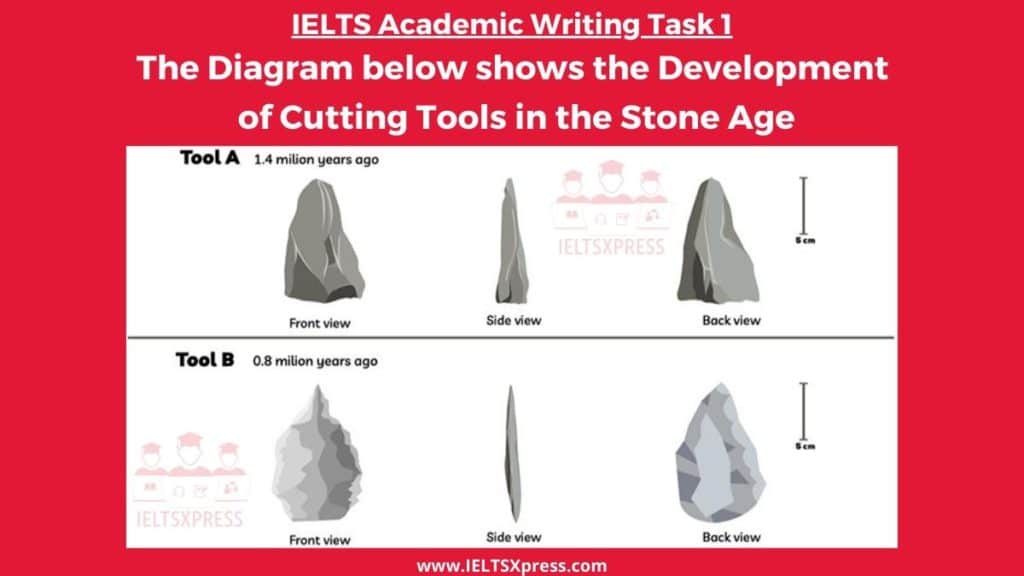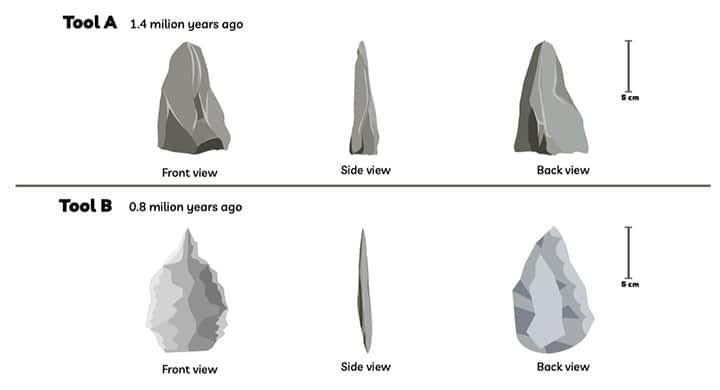IELTS Academic Writing Task 1 – The Development of Cutting Tools in the Stone Age
You should spend about 20 minutes on this task.
The diagram below shows the development of cutting tools in the stone age. One was made 1.4 million years ago, and the other was made 800 thousand years ago (viewing from the back view, front view, and side view).
Write at least 150 words.
Real IELTS Exam Question, Reported On:
| India | 12th February 2022 |
Practice with Expert IELTS Tutors Online
Apply Code "IELTSXPRESS20" To Get 20% off on IELTS Mock Test
The Development of Cutting Tools in the Stone Age – Sample Answer 1
The pictures describe the evolution of Stone Age cutting tools between 1.4 million and 0.8 million years ago. It can be seen that the latter design had seen vast improvements in the size, shape and finishing quality.
Tool A, which dated back to 1.4 million years ago, was rather small and rudimentary. At about 7cm in length, the tool was thin and did not display much craftsmanship. The front and back views were plain with only some slight chiseling effort while the side was rough and not very indicative of a cutting utensil.
Tool B showed many updated features compared to the older version. First of all, it was larger and sturdier due to a better water drop design with a broad base and a pointy top. Second, both front and back sides were grounded more evenly and smoothly. Finally, although the tool’s thickness stayed relatively the same after 0.6 million years, the side edge was undoubtedly much more finely sharpened.
IELTSXpress
The diagram below shows the Development of Cutting Tools in the Stone Age – Sample Answer 2
The diagrams depict two stone tools used by ancient humans, dated from two different periods of time: 1.4 million years ago and 80000 years ago.
In general, the shape of the newer tool looks sharply different compared to the older one although their sizes are relatively the same.
Over 1.4 million years ago, the cutting tool was a jagged piece of rock. The front and back surfaces are uneven with many cracks and chipped edges while looking from the sideshows this primal tool has a certain thickness and is slightly curved at the top. However, there is no definable sharp tip or edge. IELTS X press
Compared to the earlier version, the tool from 80000 years ago has a much more well-formed shape. The edges and surfaces had been smoothly polished with one end sharpened to a tip and the other flat, similar to the shape a teardrop or a leaf. Additionally, from its side view, the new tool is visibly slimmer than its older counterpart. In a way, this tool more closely resembles modern cutting tools such as a knife.
IELTS Stone Age Tools Diagram – Sample Answer 3
The pictures describe the cutting tools created by our ancestors at two different ages.
Tool A was made approximately 1.4 million years ago. It was like an animal tooth about 8 cm long with a rough surface. It may be easy to hold but it was barely sharp enough. As is shown, the front part of the cutting tool was rather broad, and its top area was a little smaller than the bottom. Seen from the side, it was just as narrow as a stick. Moreover, the back part was much flatter than the front part.
Tool B was widely used 0.8 million years ago. Both of the two tools were made of stone. However, Tool B had been better developed than the previous one. It was about 12 cm long. Its front part had been smoother with many little points, which made it similar to the surface of a diamond. Observed from the side, it had got a very acute top, which was very useful for slicing meats. In addition, the back part was even much flatter than that of the older tool.
IELTS XPRESS
IELTS Writing Task 1 Prehistoric Tools – Sample Answer 4
The presented illustration demonstrates the cutting stone tool and how it transformed from 1.4 million years ago to 800 thousand years ago. It is clear that the same tool underwent improvements and turned sharper and much better.
The stone tool made 1.4 million years ago was more rounded at the top and bottom edges. From the front and the back view of the tool, it is clear that the diameter in the middle was almost 5 cm, and towards the top and bottom, it was around 3 cm wide. The side view shows that the tool was wider in the middle, with a diameter of approximately 3 cm, and it tapered towards the top, and the bottom ends. The back of the stone had fewer cuts than the front, and they were also not very fine.
800 thousand years ago, this tool developed into a sharper, more refined one. The front and the back view show that the maximum diameter of the tool was the same as in the older tool, but it was more towards the lower side. The bottom tapered into a 1 cm point, but the top tapered more sharply into a 1 cm point. The side view clarifies that it was much lesser in width (1.5 cm) than the older tool. The stone was more chiseled than the previous one.
IELTS Academic Writing Task 1 Stone Age Tools – Sample Answer 5
The illustration depicts the tool for cutting from the Stone Age in two different periods including tool A from 1.4 million years ago and tool B from 0.8 million years ago.
Overall, it is noticeable that both tools share a similar shape, however, innovation in manufacturing these tools is observed as tool B is considered to be more advanced and complex than tool A.
From 1.4 million years ago, Stone Age tools have triangle structure with a length of approximately 7 cm from both front and back view, which had a blunt head to go hunting or cut food on purpose. Therefore, it indicated a basic tool-making technique at that period as it retained all the characteristics of natural rock with a rough surface from both views. ielts xpress
However, tool B represented the advancement in the manufacturing process. It was relatively larger in size with a sharpened tip and edges, which were viewed from front and back. Also, it had a water-drop shape with a round bottom which was completely fit the user’s hand. The special feature was the thin level of the tool was increased to escalate the job performance
IELTS Graph Writing Task Cutting Tools – Sample Answer 6
The diagram presents a comparison of prehistoric tools dating back 1.4 and 0.8 million years ago. Overall, the older tool is less refined with rougher edges, while the newer one appears smoother and better preserved.
Comparing the two tools from the frontal view, the one from 1.4 million years ago is slightly narrower, displaying a less defined shape. The more recent one comes to a sharper point with clearly rounded sides.
The side view reveals that the older tool is also bulkier with more jagged indents than the much smoother one from 800,000 years ago. Finally, in terms of the back view, there is a distinct contrast as the newer has fewer major cracks and closely mirrors its front side. The older tool, on the other hand, is approximately half the size overall and is chipped down greatly in the back.
IE LT SX PRESS
IELTS Diagram on Cutting Tools – Sample Answer 7
The development of cutting tools from 1.4 million years ago to 0.8 million years ago in the Stone Age is delineated in the given diagram.
It is clear from the diagram that the overall features of the tools became more user-friendly over the years.
As seen in the chart, about 1.4 million years ago, the front view of the tools was similar to a sharp triangle, pointed at the top with blunt edges. However, after 0.6 million years, the tools became more pointed at the top, and the edges became sharper. The maximum diameter at the middle increased from just 3 cm to 5 cm, and the bottom was shaped without irregular edges.
When looking from the side, the width of the tools reduced by around 2 cm, with the top and bottom edges sharper compared to how it was 1.4 million years ago. ieltsxpress.com
When looking from the backside, from a conical shape, the tools appeared to be more or like oval in shape in the later period. The overall height of the tools was also reduced by about 2 to 3 cm so that it became handier.
The Development of Cutting Tools – Sample Answer 8
The given diagram compares stone age cutting tools at 1.4 million and 0.8 million years ago. Overall, the latter one appears to be bigger in size and its shape was also better refined with sharper, more uniform edges and a pointed end.
To begin with, tool A, dated 1.4 million years ago, has a height and width of about 7.5 and 3 centimeters respectively and is around 1-2cm thick. From the front view, there were large random cuts that created rough edges and a tapered end. From the other sides, similar cuts can be seen, and a sharp end was formed at the top of the tool.
Turning to Tool B, we can see that after 0.6 million years, the cutting tool had doubled in size, with a height of about 10 centimeters and a width of slightly over 6 centimeters, whereas it retained a similar thickness. A look from the front and the back of tool B reveals that its outer shape became significantly finer with a sharp pointy top and a smoothly curved bottom. Its side view also witnessed a remarkable transformation which made the tool take the shape of a leaf with a sharp edge running across the tool.
IELTS Xpress
The Development of Cutting Tools Writing Task 1 – Sample Answer 9
The diagram illustrates the development of the cutting tool from two different time periods within the Stone Age.
Although the overall size and shape of the two cutting tools are very similar, the cutting tool from the latter time period shows some distinct improvements.
Tool A is a depiction of a Stone Age cutting tool used approximately 1.4 million years ago, while tool B is from a later part of the Stone Age approximately 0.8 million years ago. Both cutting tools are similar in shape and size, being roughly 10cm in length. However, tool A looks to be quite a crude implement, while tool B appears to have been refined into a more effective cutting device.
From the front and rear view, tool B appears to be much wider than tool A and has a rounded body shape. The cutting edges also appear to be more distinct and symmetrical. The side view shows a distinct difference in the thickness of the two tools, with tool B significantly slimmer than tool A.
IELTS Academic Writing Task 1 – Sample Answer 10
The illustration shows the improvement of slicing tools during the stone age.
It can be seen that tool A is thicker compared to tool B. Aside from that, the shape of the stone cutting tool in tool A looked more like a Triangular in shape as compared to tool B which looks curvy.
The shape of the cutting mechanism from 1.4 million years ago looked like a shape of an arrowhead with straight edges on the side part, while the shape of the cutting tool from .8 million years ago looked like a flat circular stone with curvy and sharp edges.
The thickness of tool A shows that it has a thicker stone slab, whereas the thickness of tool B has only merely a half of the thickness of tool A. The back portion of both cutting tools more likely has the same look as it shows in the front part.
The Diagram on Cutting Tools in Stone Age – Sample Answer 11
The illustration highlights the advancement of Stone Age cutting tools by contrasting one made 800,000 years ago with its predecessor dating back 1.4 million years. i e lts xpr ess
It is clear that the earlier tool (tool A) looked very simple while the later one (tool B) was more complex and finely produced. Major differences can be found in their shapes, edges and tips.
Specifically, tool A was characterized by rough surfaces and edges. It was around 7 cm in length and had a small tip that looked sharp when viewed from the back but fairly blunt if viewed from the front. Overall, the tool had no particular shape and retained all characteristics of natural rocks, indicating basic tool-making techniques of that period.
Tool B, however, showcased a more advanced and elaborate manufacturing process. It was relatively larger in size and had skilfully sharpened tips and edges. Particularly, it was shaped like a pointed leaf with perfect symmetry and a round bottom to comfortably fit the user’s hand. These desired features were obviously the outcomes of delicate workmanship that had allowed prehistoric humans to get a better grip of gathering, butchering and woodworking.
Cutting Tools in Stone Age IELTS Writing Task 1 – Sample Answer 12
The diagrams compare the features of two paleolithic hand axes crafted by early humans in two separate periods of the stone age, the middle and the later. Two viewpoints, face-on and edge-on, are given for each axe. ielts xpress
As it can be seen from the first figure, the middle stone age axe had an irregular leaf shape. Its length was approximately 6 cm and its base width was comparatively less only about 3.5 cm. Its thickness was about 2.5 cm. The shape of the middle line in the edge-on view suggests that one face was thicker than the other.
Focusing on the later stone age axe, changes in the shape and size of the tool are clearly visible. It had a more streamlined triangular shape with a broad base and a pointed tip. It was about 1.5 cm longer and 1 cm thinner than the middle stone age hand axe. Interestingly, the thickness of both faces was roughly the same.
Overall, the shapes of the stone hand axes were similar in both periods but the hand axe crafted in the later paleolithic period was relatively smoother and slimmer.
Also Check: The Diagram below Shows How Salt is Removed from SeaWater




